Conformational equilibria in allosteric control of Hsp70 chaperones
- PMID: 34453889
- PMCID: PMC8500941
- DOI: 10.1016/j.molcel.2021.07.039
Conformational equilibria in allosteric control of Hsp70 chaperones
Abstract
Heat-shock proteins of 70 kDa (Hsp70s) are vital for all life and are notably important in protein folding. Hsp70s use ATP binding and hydrolysis at a nucleotide-binding domain (NBD) to control the binding and release of client polypeptides at a substrate-binding domain (SBD); however, the mechanistic basis for this allostery has been elusive. Here, we first characterize biochemical properties of selected domain-interface mutants in bacterial Hsp70 DnaK. We then develop a theoretical model for allosteric equilibria among Hsp70 conformational states to explain the observations: a restraining state, Hsp70R-ATP, restricts ATP hydrolysis and binds peptides poorly, whereas a stimulating state, Hsp70S-ATP, hydrolyzes ATP rapidly and has high intrinsic substrate affinity but rapid binding kinetics. We support this model for allosteric regulation with DnaK structures obtained in the postulated stimulating state S with biochemical tests of the S-state interface and with improved peptide-binding-site definition in an R-state structure.
Keywords: DnaK; Hsp70; allosteric regulation; crystal structure; molecular chaperone; protein folding.
Copyright © 2021 Elsevier Inc. All rights reserved.
Conflict of interest statement
Declaration of interests The authors declare no competing interests.
Figures

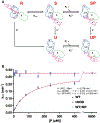
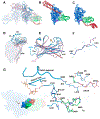
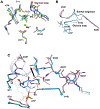
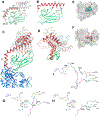
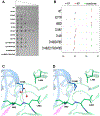
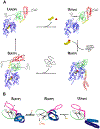
Similar articles
-
Allosteric opening of the polypeptide-binding site when an Hsp70 binds ATP.Nat Struct Mol Biol. 2013 Jul;20(7):900-7. doi: 10.1038/nsmb.2583. Epub 2013 May 26. Nat Struct Mol Biol. 2013. PMID: 23708608 Free PMC article.
-
Intermediates in allosteric equilibria of DnaK-ATP interactions with substrate peptides.Acta Crystallogr D Struct Biol. 2021 May 1;77(Pt 5):606-617. doi: 10.1107/S2059798321002436. Epub 2021 Apr 14. Acta Crystallogr D Struct Biol. 2021. PMID: 33950017 Free PMC article.
-
Pathways of allosteric regulation in Hsp70 chaperones.Nat Commun. 2015 Sep 18;6:8308. doi: 10.1038/ncomms9308. Nat Commun. 2015. PMID: 26383706 Free PMC article.
-
Hsp70 chaperone dynamics and molecular mechanism.Trends Biochem Sci. 2013 Oct;38(10):507-14. doi: 10.1016/j.tibs.2013.08.001. Epub 2013 Sep 5. Trends Biochem Sci. 2013. PMID: 24012426 Review.
-
Intra-molecular pathways of allosteric control in Hsp70s.Philos Trans R Soc Lond B Biol Sci. 2018 Jun 19;373(1749):20170183. doi: 10.1098/rstb.2017.0183. Philos Trans R Soc Lond B Biol Sci. 2018. PMID: 29735737 Free PMC article. Review.
Cited by
-
Cholesterol-dependent enzyme activity of human TSPO1.Proc Natl Acad Sci U S A. 2025 Apr;122(13):e2323045122. doi: 10.1073/pnas.2323045122. Epub 2025 Mar 27. Proc Natl Acad Sci U S A. 2025. PMID: 40146857
-
Hsp70 in Redox Homeostasis.Cells. 2022 Feb 28;11(5):829. doi: 10.3390/cells11050829. Cells. 2022. PMID: 35269451 Free PMC article. Review.
-
The dual-function of HSP70 in immune response and tumor immunity: from molecular regulation to therapeutic innovations.Front Immunol. 2025 Apr 14;16:1587414. doi: 10.3389/fimmu.2025.1587414. eCollection 2025. Front Immunol. 2025. PMID: 40297581 Free PMC article. Review.
-
Tandem repeats of highly bioluminescent NanoLuc are refolded noncanonically by the Hsp70 machinery.Protein Sci. 2024 Feb;33(2):e4895. doi: 10.1002/pro.4895. Protein Sci. 2024. PMID: 38284490 Free PMC article.
-
AlphaFold-guided molecular replacement for solving challenging crystal structures.Acta Crystallogr D Struct Biol. 2025 Jan 1;81(Pt 1):4-21. doi: 10.1107/S2059798324011999. Epub 2025 Jan 1. Acta Crystallogr D Struct Biol. 2025. PMID: 39711199
References
-
- Adams PD, Afonine PV, Bunkóczi G, Chen VB, Davis IW, Echols N, Headd JJ, Hung L-W, Kapral GJ, Grosse-Kunstleve RW, McCoy AJ, Moriarty NW, Oeffner R, Read RJ, Richardson DC, Richardson JS, Terwilliger TC, and Zwart PH (2010). PHENIX: a comprehensive Python-based system for macromolecular structure solution. Acta Crystallogr. D 66, 213–221. - PMC - PubMed
-
- Anfinsen CB (1973). Principles that govern the folding of protein chains. Science 181, 223–230. - PubMed
-
- Buchberger A, Theyssen H, Schroder H, McCarty JS, Virgallita G, Milkereit P, Reinstein J, and Bukau B (1995). Nucleotide-induced conformational changes in the ATPase and substrate binding domains of the DnaK chaperone provide evidence for interdomain communication. J. Biol. Chem 270, 16903–16910. - PubMed
Publication types
MeSH terms
Substances
Grants and funding
LinkOut - more resources
Full Text Sources
Molecular Biology Databases

